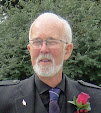When commenting on Scriptor's
Rambles From My Chair posting entitled
Odd (and I mean odd!) Facts Adrian said "Street numbers reminds me of a road up your way where, I believe, they number the houses as they build them so 100 could be next door to 15. Is this so or was I in the wrong bar again?"
It got me to thinking. Adrian's quite correct about the randomness of the numbers of houses but the explanation is not quite so simple.
There are at least three types of numbers by which property (known in Scotland as 'subjects') in the Western Isles - Outer Hebrides - can be known: a street number (mainly in Stornoway), a croft or allotment number (almost anywhere outside Stornoway or parts of Benbecula) or a
feu number. Crofts have been defined colloquially as the farming of fences because they are often long narrow strips of land. This map of two townships (villages) near Eagleton shows the layout of the crofts.

Each croft is numbered and the croft house will also bear that number. The number may be quite unusual if, for example, a croft is divided the house may be known as One Half Of Five or "1/2 of 5 Such and Such a Place" Try entering that address on an official form! There may be more than one house on the croft with the same number. There was (and perhaps still is) a case in Lewis where there were five houses all with the same Township Croft number and two of them had people (father and son) with the same Christian and surname. Postie eat your heart out.
Allotments (upon which a house may often be built) are numbered in various ways by various Grazings Committees who allocate them. So far as I know they are generally numbered sequentially as they are granted.
Feus are often numbered in the same way as allotments if they are granted outwith a croft but if they are feud off a croft (ie part of a croft taken out of crofting tenure and turned into a feu) they will usually bear the original croft number with the addition of the suffix 'a'.
So my first house on Lewis bore the address 22a Coll because it was a feu off croft 22. The house next door had been an allotment and was then feud. It bore the number 73.
Years ago a road in Stornoway had been developed in various ways at various times and had five different sets of numbers many of which were, of course, the same. So there were five houses numbered 1. The Council decided, after a request from the Post Office, to exercise it's powers and impose a 'proper' single numbering system from one end to the other. No one would think twice about such a rationalisation now but 30 years ago it caused a major stir.






















































